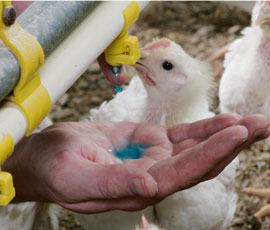Biosecurity key to beating Gumboro

Gumboro affects significantly more poultry flocks than producers realise, and a new approach is needed to tackle this hidden disease.
Dr Tibor Cserep, technical manager at Intervet/Schering-Plough Animal Health, says Infectious Bursal Disease, or Gumboro, is the most important poultry disease worldwide, causing considerable losses in both its clinical and sub-clinical form. “It is like an iceberg – only one ninth is visible, the rest is submerged,” he told a recent Datapoul conference in Devon.
Gumboro can survive in the external environment for months, and attacks the bird’s immune system. It is particularly dangerous in young chicks, targeting the liver, heart, kidney and bursa of Fabricious. It multiplies in the bursa – a vital organ that produces stem cells and white blood cells to fight disease – potentially causing massive infection and death.
In clinical cases, birds suffer from poor feed conversion and higher mortality, slashing profitability by 30%, says Dr Cserep. But a far greater problem is the hidden, or sub-clinical cases, where symptoms are hard to identify.
Any challenge to the bursa devastates the bird’s immune system, rendering it far more susceptible to infection by other diseases such as coccidiosis, E coli and Marek’s. “You will also get a very poor response to vaccinations,” says Dr Cserep. Most chicks inherit some immunity from their mother, via the yolk, but this disappears after three weeks or less. They therefore need to be vaccinated to provide ongoing immunity – but vaccination too early will be undermined by existing antibodies; too late and the chicks are exposed to disease.
“Broilers need a healthy bursa to day 21 – any atrophy before that results in permanent immuno-suppression, which can damage the profitability of your flocks very badly,” says Dr Cserep. “You will see more disease, an uneven flock and poor performance; flocks without sub-clinical Gumboro infection will have 25% higher income than those with it.”
Producers should ideally blood sample their chicks and use the Deventer formula to identify the correct date to vaccinate for best results. “But vaccination alone will not solve a Gumboro problem,” says Dr Cserep. “Biosecurity and cleanout are very important; ideally you want an all-in, all-out system, with adequate down time and good disinfection procedures.” Multi-age sites are a hotbed for disease, and producers should also consider the biosecurity risk posed by thinning teams.
Producers should use a more potent vaccine in high-risk flocks, and vaccinate twice if the chicks show a wide range of maternal antibody levels, he adds. Administration technique is also critical as chlorine in water can inactivate the live vaccine. It is therefore essential to fully drain water lines – not just allow birds to drink them dry – and use a dye to check delivery of the vaccine.
“Gumboro can appear on your farm unexpectedly, and take a lot of money out of your pocket without you realising. Vaccination and bio-security are the cornerstone of any disease control strategy, but you need to apply the correct vaccine, at the correct time, in the correct way,” says Dr Cserep.
